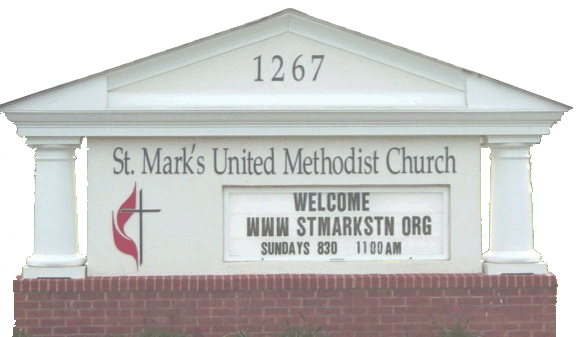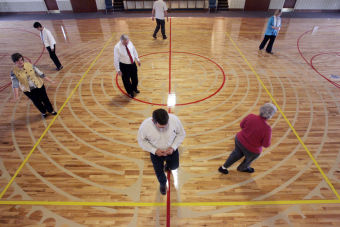











|
|
||
| Labyrinths can be made from canvas, bricks, stones, mowed
in the grass, grown out of shrubs (like the one at Stratford Hall, carved
into metal or wood etc.). Today they can be found in parking
lots, in hospitals (did you know MTMC has a labyrinth?), on sandy beaches,
and at retreat centers. St. Mark’s painted labyrinth is a medieval,
11-circuit (circle) labyrinth, a very close replica of the most famous
labyrinth of inlaid stone on the floor of the Chartres Cathedral in France.
The Chartres labyrinth is nearly 40 ft. across, and our labyrinth is very
close to the same size.
How is a Labyrinth different from a Maze? A labyrinth is not a maze. The route of a maze is designed for you to lose your way, to keep you lost or confused. A Maze is full of dead ends and detours that keep you from finding your way out. A labyrinth is designed for you to find your way. A Labyrinth is a single winding course of concentric circles that leads to a center point. And even when we've reached the center, our journey is not complete. It's only half over. We're not just to walk away, but to reach our steps back out to complete the full cycle. Labyrinth walking supports flow, not force; cooperation, not competition. The symbolic takes precedence over the literal. Is the Labyrinth a Christian Symbol? Some people think the labyrinth is evil or pagan. The labyrinth is neither inherently Christian nor non-Christian. Like the symbols of the Advent wreath and the Christmas tree, which both began as pagan practices and were later "baptized" by the church and infused with Christian meaning, the labyrinth has been adapted to our faith tradition in the same way. A labyrinth is merely a tool that helps us bring a spiritual reality into a tangible experience. -- Kautz What does it mean to pray the labyrinth? Why is the labyrinth called a path to prayer? There are many different kinds of prayer, and thousands (85,000+ on Amazon.com!) of books about prayer. There are prayers that we know by heart, such as The Lord's Prayer or The Hail Mary. There are long prayers and short prayers. There are talking prayers and there are listening prayers. Choosing to pray is like making a commitment to focus your time and attention on growing in the Spirit. Walking the labyrinth is a body prayer, a prayer one does with the whole body. -- Camp Walking the path into the center of the labyrinth is a metaphor for finding one's own center or finding God. Walking out of the labyrinth is a symbol of being reborn into the world.-- Camp The Labyrinth is an outward pilgrimage that mirrors and inward journey -- Kautz The labyrinth is more about the journey than the destination, more about being than doing. By incorporating a physical journey into this time of prayer, the labyrinth integrates body and mind, reason and imagination, thought and feeling into one harmonious whole. Simply put, the labyrinth is a space that guides the mind and heart. -- Patricia D. Brown How do you walk a labyrinth? There is no right or wrong way to walk a labyrinth. There are as many ways to walk a labyrinth as there are labyrinth walkers. -- Artress The labyrinth is a spiritual tool meant to awaken us to the deep rhythm that unites us to ourselves and to the Light that calls from within. The labyrinth connects us to the depths of our soul, so we can remember who we are and whose we are. All labyrinths have an opening or starting point, several circles, and a center point. On the medieval labyrinth, the center point is called the clover. On our labyrinth, you do not walk on the paint, but on the path between the paint. Prior to walking any labyrinth, you may find it helpful to just sit and relax, to say a prayer, read scripture, or sing a hymn. Spend a few minutes in transition from the outside world to a place of quiet and a feeling of calm. Today, you may choose to read the verses posted around the room, centering your heart on Jesus, or simply wait in silence for a time to walk. One of the ancient mystics of the Middle Ages, Hildegard of Bingen, suggested these three stages of walking the labyrinth: 1) Entering or Purgation, The inward journey – a time of emptying and letting go. Walking toward the center, we release our cares and concerns, shedding the confusion and busyness of your mind, emptying and quieting ourselves before God, opening yourself to God’s insight and grace. One finds the center if one stays on the path. As we surrender to the winding path, we seek wholeness and healing in Christ. 2) Reaching the center, Illumination – Pray and meditate within the circle, seeking clarity and insight for your life. Remain as long as you wish, receiving whatever word or direction God has for you. This is an excellent space to meditate on a specific care, verse, question or joy. Walk in silent reflection, letting go of the feelings, emotions and thoughts that bog you down and limit you. Create an inner space where God and enter your life, your heart, your mind, your soul. Rest in God. Experience and taste the inner peace you seek. As distracting thoughts spring up, focus on a sacred word or special image to dispel them and return to inner silence. Be at peace in the silence. 3) Returning or union, the outward journey – As we walk out on the same path, we are empowered by the spirit to be more authentic in ourselves and in our service to the world. Think of this as a time of initiative, becoming the hands of God. Walking Tips As you begin, pause at the entry as you become fully conscious of stepping into the labyrinth. There are a number of people here today, more than can be on the labyrinth at one time. Allow about a minute or several turns of the labyrinth to lapse between you and the person in front of you. When walking the labyrinth, it is important that you "find your rhythm." Walk at a pace that is comfortable for you. If you move more rapidly than the person in front of you, move around the person. If you are moving more slowly than the person behind you, allow that person to pass. Remember that you do not walk alone, but in community, and the path is a two-way street. You will meet people coming in, going out, facing you, and joining you in the center. If you want to maintain a meditative stance, avoid eye contact. When you encounter another person, do not worry about doing anything wrong – one of you will simply step aside to let the other pass. Sometime, you may choose to be spontaneous, dance, carry a flower a shell, or some other object or symbol that is significant to you. You can be free, joyful and even playful in a labyrinth, as long as you are not disturbing others! Today we will walk in silence, another day we may walk with music. We ask that you walk the indoor labyrinth without your shoes unless you need the support of your shoes to walk. Do what feels comfortable for you. Be conscious of your breathing. Let your breath flow smoothly. Each experience in the labyrinth is different. The labyrinth is a way of opening ourselves to what God shares with us on the journey. If you like, we can meet together to share our experiences after we walk. Does Walking the Labyrinth really “work?” No time or effort is ever wasted; no matter how circuitous the course of our lives, every step takes us toward the center and moves us closer to God. -- Brown, p. 251 If we keep putting one foot in front of the other, we can quiet the mind and find our center. The journey may be difficult and the lesson is to trust the path: we all need strength for the journey. -- Walking the Sacred Path, p. 7 Be patient! This new territory may seem foreign at first. Like any spiritual discipline, walking the labyrinth is a “practice,” not an accomplishment. -- M. Touchton So, are you ready? Do you have questions? ~~~~~~~~~~~~~~~~~~~~~~~~~~~~~~~~~~~~~~~~~~~~~~~~~~~~~~~~~~~~~~~~~~~~~~~~ Questions for reflection and sharing: 1) What did you discover about prayer during your labyrinth walk? About yourself? About God? 2) What did work for you in this form of prayer tonight? 3) How was walking the labyrinth different from the way you usually pray or understand prayer? How was it the same?
|
|||
|
|||
